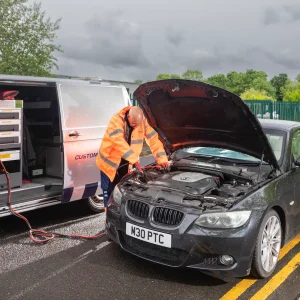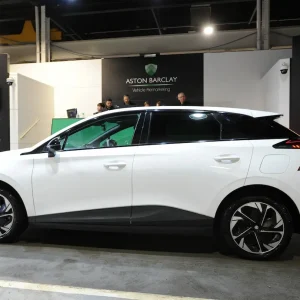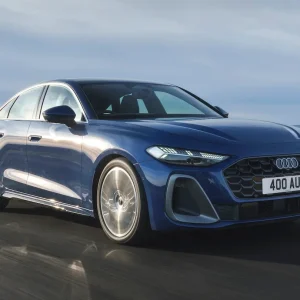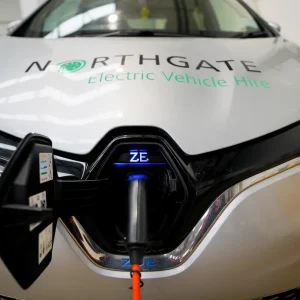The debate continues: what is the best alternative to diesel- and petrol-powered cars? Electric cars are staking a claim, but a recent European roadshow is promoting the case for hydrogen, as Rachel Burgess discovers
Electric cars have been viewed as a viable alternative to traditional engines for a couple of years now. But take-up has been slow due to pricey vehicles and limited range. Large fleets have led the field, trialling one or two cars, for short journeys or driving between buildings on a large site.
The advent of range extenders now offers a feasible alternative, but they still have high price points; take into account the increasing number of fuel-efficient petrol and diesel cars, and they’re even harder to justify for the majority of fleets.
Many people, however, think hydrogen is a longer term and better alternative for the future. For the green agenda, vehicles powered by the natural gas only emit water, compared to EVs, which need to be plugged into an electric source for charging. And, they typically can cover distances similar to a fossil fuelled-car, which removes so-called range anxiety. However, two big hurdles remain: the cost and the infrastructure for hydrogen re-fuelling.
Car manufacturers are pushing forward with mass production of hydrogen vehicles, with Hyundai, Honda, Mercedes and Toyota all showcasing fuel-cell electric vehicles (FCEV) at a recent event to raise awareness of hydrogen technologies. The European Hydrogen Road Tour 2012 travelled to nine cities across Europe including London and Cardiff and gave politicians, industry leaders, media and the public the opportunity to drive a hydrogen-fuelled car as well as learn more about it.
Hyundai has announced it is producing 1000 ix35 FCEVs, starting by the end of 2012 through to 2015, which will be available for public and private lease. And the firm has already won a tender to supply 15 cars to a council fleet in Copenhagen, which has a sufficient hydrogen fuelling infrastructure to facilitate the trial.
So, what does this mean for Britain? The London Hydrogen Partnership has been running five fuel cell buses daily between Covent Garden and Tower Gateway Station since May 2011. There’s also a fleet of hydrogen taxis, which aren’t operational as traditional cabs, but acted as chauffeured cars for special guests during the Olympics and continue to run for visitors linked to the project. Daniel Barrett from the
LHP says the transport has shown that hydrogen “holds great potential to reduce environmental impacts while maintaining the city’s [London’s] and Transport for London’s rigorous service standards”.
Infrastructure remains a problem, but fuelling points are growing. There are now 12 in the UK including two in London at Heathrow and Stratford, and a number at different universities including Birmingham, Coventry and Loughborough. The most recent site, opened earlier this month, is part of a £9m sustainable-energy research facility at the University of Nottingham. Barrett adds that the LHP hopes to have a hydrogen refuelling point in the capital’s zone one or two before the end of next year.
By 2015, the aim is for London to be a “global centre for hydrogen and fuel-cell vehicle activity and advances towards mature commercialisation by 2020”. That means the LHP wants to ensure that the capital’s “refuelling infrastructure, skills, customer base and regulatory regime is sufficiently well developed for London to be one of the early commercial launch markets for leading global (and national) automotive manufacturers of hydrogen fuel-cell electric vehicles from 2015”.
This will include market testing with bus manufacturers to achieve higher volumes of hydrogen vehicles at lower prices and, before 2020, making total cost of ownership of hydrogen taxis on a par with diesel taxis.
There will also be up to 65 vehicles deployed by the end of 2013. These will be up for tender to manufacturers that have hydrogen vehicles to offer and take-up will focus on “core private sector fleet operators”, according to Barrett. Cost implications remain unclear, but 50% of the cost will come from an EU hydrogen initiative, while the end user is responsible for the remainder. “We are looking for companies from the Greater London area that would be interested in trialling hydrogen vehicles, and are keen to hear from these businesses,” he concludes.
What’s a fuel-cell car like?
The Hyundai ix35 FCEV (Fuel Cell Electric Vehicle) looks identical to its mainstream counterpart, aside from, in this case, some hydrogen livery on the sides.
From the driver’s seat it’s very similar to a typical automatic-transmission set-up. Turn the key and you are greeted with a silent engine, although a beep informs you that the car is actually switched on. There is also an optional button that emits a sound when the engine is on if the silence is too much for you.
Aside from that, you’d be stretched to know you were driving an alternative-fuelled car. There’s instant torque, like an electric car, with a top speed of 100mph and 0-62mph of 12.5 seconds – the latter comparable to a rival Nissan Qashqai with a 1.6-litre diesel engine.
|
The Hyundai ix35 FCEV |
But how does it work? The fuel-cell stack converts hydrogen into electricity, which turns the vehicle’s motor, with water vapour as the only emission. The hydrogen is put into the car’s fuel tank with a similar nozzle to diesel and petrol engines, and the ix35 FCEV can do up to 365 miles on one fill-up, making it a long-distance and environmental dream.
The prototype we drove cost a hefty £150k, but as it goes into mass production, this price will come down. But whether the cost reduction is enough for buy-in from fleets remains to be seen.






